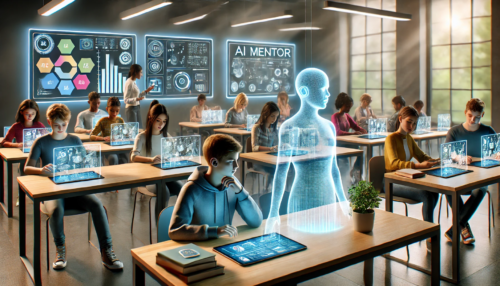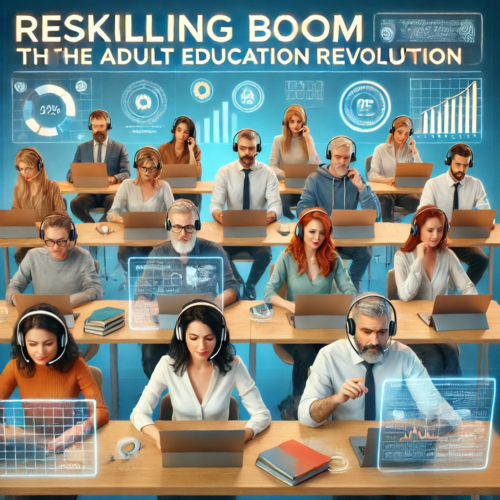Metaverse Classrooms: A VR Revolution for Students
How VR-based learning is bridging geographic barriers in education.
Have you ever wondered if students in New York can literally sit side by side with peers in rural Kenya—without hopping on a plane? It might sound like something out of a sci-fi movie, but “Metaverse Classrooms” are forging that reality in 2025. People have been buzzing about the potential of virtual reality (VR) in education for years, yet here we are, witnessing a weirdly magical transformation that’s more real than we ever guessed. I recall a random conversation I had with a childhood friend who struggled to attend regular classes due to health issues; now, they’re learning advanced robotics in a fully virtual environment. It’s not perfect—some folks get VR motion sickness, others have connectivity concerns—but the wheels are turning, and the global chatter is growing louder.
What Are Metaverse Classrooms?
People toss around the phrase “Metaverse Classrooms” like it’s candy, but what does it actually mean? Imagine stepping into a 3D digital world brimming with interactive holograms, real-time avatars of instructors, and classmates from every corner of the planet. The Eduverse platform has been a pioneer, offering educational metaspaces—like collaborative labs or historical simulations—where students can roam around, conduct experiments, and chat about tomorrow’s quiz. If you peek at ScienceDirect’s recent study, you’ll find data showing how VR learning experiences boost engagement and retention.
In these virtual realms, academic institutions no longer worry so much about geographical distance. It’s mind-blowing how an instructor in Singapore can hold real-time labs with students based in Canada or even remote villages in Nepal. As quirky as it may seem, these VR headsets and fancy glove controllers bridge more than just kilometers; they close cultural gaps, language barriers, and sometimes even generational misunderstandings. That said, if your internet decides to glitch, you might get ejected from the virtual field trip. The future can be messy like that.
Government Initiatives and Funding
Looking at the political arena—where all sorts of grand plans and questionable budgets swirl—several governments are taking metaverse education quite seriously. Some officials are allocating special grants to public schools eager to adopt VR-based curricula. A couple of years ago, I stumbled across a public hearing where local councils debated the concept of “democratizing education through technology.” Back then, many people rolled their eyes, suspecting it was another political gimmick. But come 2025, we’re seeing concrete programs, such as government-backed voucher systems that fund VR headsets for underprivileged students.
- Subsidized VR Hardware: In countries like South Korea and parts of Scandinavia, officials have launched pilot projects supplying low-income households with refurbished VR gear so kids can access these digital classrooms.
- Training Grants: Programs offering support to teachers who need help adapting to immersive tech. You’d be surprised how many educators struggle with 3D lesson planning.
- Public-Private Partnerships: Governments collaborate with private tech companies (some big names in the VR arena) to develop robust software for mass usage.
While critics argue these investments might misplace priorities—“Why not fix the basic infrastructure first?” they ask—there’s no denying that a wave of official support is propelling metaverse learning from dream to daily practice.
The Political Debates—A Glass Half Full or Half Empty?
Politics and innovation can be awkward dance partners. Some progressive parties champion the metaverse as a stepping stone to universal education. They argue that bridging geographic barriers fosters equality and global collaboration, which in turn drives economic prosperity. Meanwhile, more conservative factions raise concerns about privacy, data security, and potential corporate monopolization of virtual “school grounds.”
Over the past year, a heated debate in the European Parliament zeroed in on whether VR headsets might inadvertently collect sensitive biometric data—like your gaze patterns or heart rate—then store it in questionable data lakes. “We must protect our children,” one minister exclaimed, calling for stricter regulations on how VR software collects and uses personal information. So, yes, it’s not all sunshine and rainbows; where technology grows, controversy usually follows. Still, there’s widespread agreement that VR-based learning has legitimate educational merits, provided we address these ethical dilemmas.
Insights from Research Labs and Scientists
Ever wonder how scientists feel about these blossoming metaverse environments? Let’s take a quick detour to IEEE Xplore’s latest publication analyzing VR-based educational models. The gist? Early empirical evidence suggests that immersive learning can significantly enhance concentration, spark creativity, and improve critical thinking skills. Researchers at specialized labs also found that VR learning experiences stimulate multiple brain regions simultaneously, leading to deeper cognitive engagement.
“Students who participated in VR-based social studies lessons retained information for longer periods compared to those in traditional classrooms,” notes Dr. Marina Sovic, a cognitive scientist featured in one of the journals. She also pointed out that these virtual experiences can encourage cross-cultural empathy, as learners interact with peers of diverse backgrounds in real time.
Another angle? Some labs are experimenting with advanced haptic suits, letting students not just see and hear but also “feel” certain elements in the virtual environment—like a mild vibration indicating a simulated chemical reaction. Sure, it might sound futuristic—and occasionally glitchy—but the emphasis is on building more immersive educational methods that go beyond static texts.
Celebrity Buzz: From Movie Stars to Pop Icons
Celebrities can sway public opinion faster than an over-sugared toddler flipping moods. A globally renowned pop star—famous for philanthropic endeavors—recently endorsed a VR literacy campaign, urging fans to imagine a world where “any kid can access the finest tutors, from Harvard to your living room.” She even hinted at plans to produce an interactive concert in the metaverse, funneling part of the revenue into educational VR grants. Talk about synergy.
Then there’s that well-known action-hero actor who hopped into a VR classroom for an online demonstration and promptly declared, “I’m never going back to chalkboards again.” It was part marketing stunt, part genuine curiosity. Love or hate celebrity endorsements, the star power tends to push public conversation forward. Sometimes it’s shallow hype, but often it’s the spark that propels new ideas into mainstream acceptance.
Older Generations: Mixed Feelings and Cautious Optimism
“I barely understand these newfangled gadgets,” my grandmother would say whenever the conversation turned digital. A typical sentiment from older folks, who often worry that the warmth and camaraderie of face-to-face learning might evaporate in a sea of 3D headsets. Some seniors, especially those who taught in traditional classrooms for decades, question whether virtual contact can deliver the intangible joys of education—things like subtle mentorship, hallway chats, or even the sense of place one gets from physically being on campus.
At the same time, a surprising chunk of the older generation sees potential. “If I had access to this technology decades ago, I might have learned six languages and been an astronaut,” joked one retired teacher. There’s also the notion that VR-based platforms can help them continue lifelong learning without geographic limitations. So, while skepticism lingers, curiosity is quietly winning hearts.
Socially, some seniors express concern that remote VR-based schooling might encourage isolation. But advocates argue that these digital realms actually foster international bonding. Paradoxically, a sense of community can bloom when learners across continents interact daily. It’s not always a tidy scenario—accents get misunderstood, connections can drop—but the bigger picture spells synergy.
Youth Voices: The Cool and the Confused
Meanwhile, younger generations (some call them Generation Z or the Alphas) largely embrace the concept. To them, digital platforms feel like second nature. They grew up FaceTiming grandpa and ordering pizza by tapping an app. The idea of tossing on a headset to attend a geometry lesson in an interactive 3D environment—complete with floating polygons—sounds epic.
However, not every young person resonates with the hype. Some worry that social media addictions may worsen if education merges even more with digital spaces. “Will we ever log off?” a high-schooler asked in a local news snippet. Another teen complained about the cost of high-speed internet, saying that metaverse classrooms might deepen the divide between wealthy urban dwellers and those in more rural or financially stretched regions. So, the youth viewpoint is a blend of excitement and caution: they love the futuristic vibe, but they also sense the pitfalls.
Social Aspects and the Quest for Equity
Metaverse Classrooms bring up an intriguing question: Does VR-based education actually diminish social inequities, or does it widen them? On one hand, you can attend a top-tier class from anywhere—desert, snowcapped village, overpopulated city, you name it—as long as you have a stable internet connection. On the other, internet infrastructure remains patchy in various parts of the world. Equipment costs can be daunting. Government vouchers or philanthropic grants try to alleviate some of that stress, but rollout can be slow.
Personal Anecdote Break: A friend of mine living in a small coastal town had to climb onto their roof to get a steady signal for a VR biology class. They joked about nearly falling off mid-lecture. It’s funny, but also a little scary.
Some nonprofits and NGOs are stepping in, providing “VR in a box” solutions—a carry-on kit with a solar-powered router and essential headsets. These projects aim to reach remote communities lacking stable infrastructure. It’s a patchwork approach, but it’s something. Equality in education often evolves in fits and starts, a messy dance rather than a straight line.
The Tech Setup—What Do You Need?
- VR Headset: Ranging from entry-level, smartphone-based options to high-end devices with advanced motion tracking.
- Controllers & Haptic Gloves (Optional): Let you manipulate or “touch” objects in the metaverse.
- Stable Connection: High-speed broadband is critical for seamless interaction (5G networks can help).
- Software Platforms: Eduverse, About Facebook’s Metaverse for Education, or other specialized apps.

Inside these virtual spaces, you’ll typically see avatars of classmates. In some advanced platforms, the avatars mimic real facial expressions through sensors. The aim is to replicate the nuances of real classrooms—subtle glances, nods, or maybe a random eyeroll if someone’s messing around. Some might find that creepy, others call it immersive.
Subtle Pitfalls and Contradictions
Nothing’s perfect. While VR can simulate field trips to the moon, it can’t fully replace the intangible energy of in-person gatherings. Occasionally, the sense of presence might feel artificial—like you’re floating in a game rather than engaging in serious academics. This can lead to some interesting confusions: are we learning or just playing?
Academic integrity is another headache. Teachers fret about how to ensure students aren’t cheating in VR-based exams—maybe they’re googling answers on a separate device. Some platforms integrate proctoring tools, but it’s a constant cat-and-mouse game.
We also can’t overlook the psychological dimension. Extended VR sessions may cause eye strain or “cyber sickness.” Researchers are investigating ways to minimize these side effects, but they haven’t found a magic bullet yet.
A Quick Look at Government Policy Shifts
- Incentives for Tech Firms: Tax breaks for companies developing advanced educational VR software.
- Cross-Border Collaborations: Diplomatic efforts to create “Global Campus Alliances,” letting students from different nations earn recognized credits via shared metaverse platforms.
- Bandwidth Infrastructure: Some political figures push for expanded 5G coverage or even satellite-based broadband to sustain real-time VR interaction in remote locales.
- Ethical and Legal Frameworks: Discussions revolve around protecting minors from possible exploitation or data breaches.
Is everything moving smoothly? Far from it. Some lawmakers worry that as government invests in VR, they’re neglecting urgent social problems. Others caution that too much government meddling might stifle creative private-sector solutions. It’s a delicate balancing act, and we can expect more legislative tussles in the near future.
Imagine the Future: Metaverse University Degrees
As we fast-forward, you might see entire universities offering degrees solely through metaverse platforms. Students would roam virtual lecture halls, attend labs that visually replicate real facilities, and network with peers from every continent. The job market, ironically, might shift because remote-friendly employees with VR collaboration skills are in high demand. Some folks predict a world where virtual teaching assistants (powered by AI) help guide your progress 24/7.
Yet, if you’re anything like me, you might also crave the occasional handshake or a physical group project. So maybe the future is a hybrid mix—part VR, part face-to-face. Education technology rarely kills off old methods entirely; it adds new layers, leading to a more dynamic mosaic of learning paths.
Celebrity Spotlight, Round Two
Yes, we already touched on celebrities, but it’s worth mentioning the non-entertainment luminaries too. Some top business moguls (remember the billionaire known for electric cars and rocket flights?) are rumored to be testing new VR-based engineering programs. Meanwhile, philanthropic organizations run by famous authors or sports icons sponsor innovative VR labs, focusing on communities that historically lacked access to top-tier education.
Such endorsements can either bring positive attention or generate controversy. Certain critics brand these moves as “vanity projects” or “tax breaks disguised as altruism.” Who’s right? Depends on who you ask. But if the end result is more kids learning in engaging ways, maybe the celebrities can wave their philanthropic flags proudly.
FAQ: Answers to Burning Questions
Q1: Is VR-based education too expensive for everyday schools?
It can be pricey, especially the high-end devices. However, government grants, NGO partnerships, and cheaper VR hardware are making adoption more feasible. The technology’s rapidly evolving, and prices often drop over time.
Q2: Can metaverse classrooms replace real-life laboratories?
They can supplement and sometimes replace certain lab activities, but real-world tactile experiences are still invaluable for specific fields. Think about advanced chemistry experiments—handling real chemicals is a different ballgame than simulating them.
Q3: What about the socialization aspect?
Metaverse classrooms allow for virtual meetups, group discussions, and global cultural exchanges. While it’s not the same as face-to-face contact, it offers unique forms of interaction that can be equally meaningful.
Q4: Are governments worldwide endorsing VR-based learning equally?
No. Adoption levels vary. Some nations invest heavily, while others remain cautious or financially constrained. Political climate, economic resources, and public sentiment all play roles.
Q5: Could VR-based learning lead to more screen addiction?
Possibly. Overexposure to digital platforms is a concern. Balanced usage, regular breaks, and guidelines to maintain mental and emotional health are essential.
Unlocking Possibilities, Mindful of Realities
Take a mental snapshot of this era. We’re at the dawn of something that could revolutionize education for good—or create new sets of challenges we haven’t fully grasped. Metaverse Classrooms, for all their glitz, are still evolving. The synergy between government policies, research breakthroughs, political willpower, and public sentiment will determine whether we seize the technology’s potential or let it slip into novelty.
And let’s face it: VR goggles might feel awkward. Some parents still wonder if this is all a trend that’ll fizzle out. They might say, “A decade from now, we’ll look back at these huge headsets and laugh.” But at the same time, innovations often feel clunky in their early stages. I recall the first smartphones—huge, battery-guzzling bricks. Now, they’re sleek, indispensable tools.
So maybe Metaverse Classrooms are stepping stones toward a more interconnected world, one that fosters educational access for the many rather than the few. That dream might be ambitious, riddled with controversies, and peppered by software bugs. But if you believe in shaping a global community through shared learning experiences, you’ve got to at least tip your hat to the potential.
Final Thoughts & A Friendly Nudge
Ready to explore the metaverse for yourself? Start by researching grants or local pilot programs in your area. Some big universities host “open house” days in their VR platforms—plenty of chances to get a taste of what it’s like. Or maybe you just want to join an online forum to ask questions about hardware. Trust me, you’re not the only one feeling overwhelmed.
For more insights and related updates, check out:
- Eduverse – A trailblazer in online immersive learning
- About Facebook’s Metaverse Education Blog
Our community thrives on shared stories, so drop a comment below if you’ve tested a Metaverse Classroom yourself. Share your slip-ups, triumphs, or that moment you realized your avatar was dancing in the virtual hallway by mistake. Because in this evolving digital odyssey, every little anecdote helps someone else feel less lost.
Keep learning, keep connecting—and maybe we’ll see each other in the Metaverse soon.




